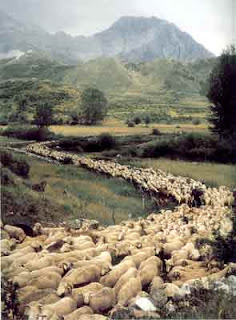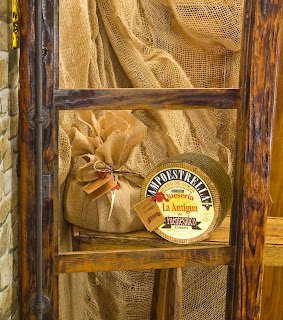pastoral culture
Zamora ‘s cheese-making tradition is endorsed by the fact that it is one of the provinces with the highest sheep’s milk production in Spain. Zamorano cheese is made with raw milk from sheep of the Churra and Castilian breeds fed on extensive grazing. That is, based on the use of crops and natural meadows and pastures. All this, together with a handcrafted elaboration, makes it possible to obtain a product of supreme quality.
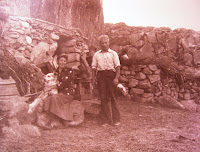 The written sources also speak of the great implantation of sheep in the area during the Middle Ages and, in particular, there are specific references to the production of cheese and its importance in the diet. In the 11th century, agrarian contracts are recorded where, as compensation for the personal services that the vassals have to provide to the lord, the bread, wine and cheese that the lord has to provide as food are mentioned.
The written sources also speak of the great implantation of sheep in the area during the Middle Ages and, in particular, there are specific references to the production of cheese and its importance in the diet. In the 11th century, agrarian contracts are recorded where, as compensation for the personal services that the vassals have to provide to the lord, the bread, wine and cheese that the lord has to provide as food are mentioned.
Another source of information of interest regarding livestock and cheese production is the cadastre of the Marqués de la Ensenada, carried out in 1752, as well as the municipal accounts of festivals and tributes to illustrious people that are preserved in Zamora, Benavente and Toro since the sixteenth century, which provide abundant information on the consumption of cheese in them, especially in the form of pastries.
Finally, mention must be made of the oral tradition still collected by historians and the survival of a pastoral culture that is still alive in many villages in Zamora, where traditional shepherding is still practiced. The testimonies collected refer to the traditional way of making cheese in the land, which were acquired by traders arriving from the south with their wagons well stocked with oil for sale, and to the undisputed fame of the Zamoran cheese makers who were sometimes required as masters from different parts of the country.
Today, the artisans in the sector continue to make cheese using the same methods they learned from their ancestors, incorporating everything that serves to improve a product called Zamorano Cheese.
Since May 1993, Zamorano Cheese has been part of the select group of cheeses protected by denomination of origin, and among them is our prestigious Queso Vellón de Fuentesaúco.
Noble and ancient cheese, considered one of the most popular in Spanish gastronomy. Made with milk from sheep of the “churra y leonesa” breed, fed on natural pasture from the province of Zamora, Spain. In 2006 it was considered by the World Cheese Awards as the best Spanish cheese of the year, awarded with a gold medal.
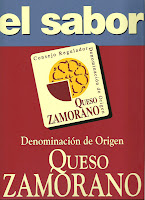 When tasting this particular cheese, considered one of the most expensive in Spain, you will notice that it has an aroma and flavor with a strong personality, which identifies it as being very similar to Italian Parmesan cheese. Its consistency is firm, lumpy and oily, with a yellowish color on the inside and a hard rind with a dark gray appearance on the outside, but on the palate it provides an exquisite creamy sensation leaving the classic sweetness of sheep cheese. This artisan cheese surprises the taster with its delicate flavor of old walnut, pleasant spicy touches and small glazed particles with an intense but not strong flavor.
When tasting this particular cheese, considered one of the most expensive in Spain, you will notice that it has an aroma and flavor with a strong personality, which identifies it as being very similar to Italian Parmesan cheese. Its consistency is firm, lumpy and oily, with a yellowish color on the inside and a hard rind with a dark gray appearance on the outside, but on the palate it provides an exquisite creamy sensation leaving the classic sweetness of sheep cheese. This artisan cheese surprises the taster with its delicate flavor of old walnut, pleasant spicy touches and small glazed particles with an intense but not strong flavor.This pleasant firm cheese goes very well with medium-bodied red wines with marked tannins such as Shiraz, Pinot Noir and Cabernet Sauvignon. It is advisable to taste this cheese at room temperature and keep it in a cool place with temperatures between 2º C and 8ºC and store it hermetically to prevent it from absorbing humidity.
ZAMORANO Sheep Cheese:
VELLON DE FUENTESAUCO.-
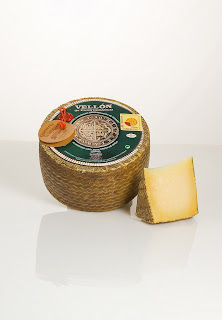 |
| FLEECE OF FUENTESAÚCO |
It is a cheese registered in the Denomination of Origin Queso Zamorano.
Zamorano Cheese is one of the most popular cheeses in Spanish
Spanish cuisine
. It has been protected by the appellation of origin since 1993. It has a traditional look and smell of the fields of Castilla y León.
Castilla y León
It is a cheese fundamentally elaborated in a traditional way exclusively with milk from sheep of the Churra and Castilian breeds, and is made from the milk of the Churra and Castilian sheep.
Zamora
the first Spanish province
Spanish province
in sheep’s milk production, accounting for 18% of the national total. Zamora’s cheese production is estimated at 300,000 kg per year.
The production process is very similar to that of
Castilian cheese
but the difference lies in the use of milk from Churra sheep (native breeds), which are fed according to the rules of grazing in the area, as the initial ingredient. It has a peculiar aroma and flavors that remind you at all times that you are drinking a sheep’s milk cheese. The taste and smell remain in the mouth.
The shape is a flat cylinder, very regular and proportionate, whose most common diameter and height are 20 cm and 10 cm respectively, and weighing about 3 kg. The lateral faces are straight and have the pleita mark printed on them.
The ripening time of our Vellón de Fuentesaúco cheese is from 7 months for the 3 kg cheese and from 4 months for the 3 kg mini cheese.
With this maturation, the color of the cut is predominantly ivory with a slight yellowish tone and semi-matte surface.
The smell has an important reminiscence of sheep’s milk, warm and pleasant, complemented by hints of cooked butter and hay in the less aged cheeses, to evolve as the aging process progresses and give presence to hints of dried fruits, nuts and spicy nuances typical of volatile fatty acids, more pronounced in the older cheeses.
The mouthfeel is soft, with a very pleasant unctuous impression, somewhat adherent and with moderate elasticity in medium-ripened wines, which become increasingly friable, losing elasticity and giving way to the appearance of a floury or grainy feel as the ripening process increases.
Frank flavor, with perception of acid and salty among the elementary flavors, but balanced, reminiscent of sheep’s milk curd well evolved, with a spicy sensation that intensifies and rounds the set of flavors.
The aftertaste is fine and delicate, with enhanced fatty acid aromas perceived through the nose.
The long persistence, with slow evolution, very pleasant and subtle until its disappearance so that leaves a pleasant memory that invites to repeat the tasting.
In short, a cheese to enjoy in company, understanding this in a double meaning: in the company of our friends and relatives and in the company of the excellent breads and wines that are also produced in the same province of Zamora. It is usually served with
wines
wines of the area, such as those that belong to the
Denomination of Origin Toro
o
Ribera del Duero
. It is usually cut into triangular-shaped slices about 3 to 5 mm thick and placed on a plate, sometimes together with
quince jam
. It is usually an ideal accompaniment to grilled meats.
CHEESE:
CAMPOESTRELLA SHEEP CHEESEThis cheese is made with raw sheep’s milk from herds under grazing regime, a characteristic that gives the cheese different and peculiar flavors. It is marketed with four curing processes: SEMI-CURED (2-3 months), CURED (4-6 months), OLD (7-9 months) and GRAN RESERVA (from 12 months).
Cylindrical cheeses presented in 3 kg and 1 kg formats.
Natural bark, free of any chemical treatment, and coated with olive oil. They have a natural color in younger cheeses, and a brownish color in older cheeses. Well-marked and well-defined pleita
AThe deep roma of clean, fresh sheep’s milk; naturalness and nobility are again evident on the palate. Buttery texture, closed paste, somewhat meaty.
THE COMPANY:
 Gestion Agro Ganadera S.L, a company present in the sheep dairy sector since 1994, started up at the end of 2002 a new line of business dedicated to the handmade production of sheep cheese of the highest quality. To this end, it has completely renovated an old and prestigious factory in the town of Fuentesaúco (Zamora), a province where the most famous regional cheeses have always been produced. And it is given the name of QUESERÍA LA ANTIGUA, in honor of the patron saint of the town of Fuentesaúco, a town well known for its famous “chickpea”, which already referred to with his pen, D. Francisco de Quevedo y Villegas, in the year 1639.
Gestion Agro Ganadera S.L, a company present in the sheep dairy sector since 1994, started up at the end of 2002 a new line of business dedicated to the handmade production of sheep cheese of the highest quality. To this end, it has completely renovated an old and prestigious factory in the town of Fuentesaúco (Zamora), a province where the most famous regional cheeses have always been produced. And it is given the name of QUESERÍA LA ANTIGUA, in honor of the patron saint of the town of Fuentesaúco, a town well known for its famous “chickpea”, which already referred to with his pen, D. Francisco de Quevedo y Villegas, in the year 1639.
Every morning, tanker trucks from Gestión Agro Ganadera collect sheep’s milk from the various livestock farms. Samples are taken and subjected to strict quality controls to ensure complete food safety.
At Quesería la Antigua, cheese is made in the traditional way, with the care and attention of yesteryear. It is handmade and contains natural and organic ingredients, such as raw sheep’s milk. As it is not heat-treated and does not contain antiseptics or preservatives, it allows its natural composition to be present and participate in the whole process of coagulation, fermentation and maturation, to achieve pure aromas and flavors in the final product, a cheese of exquisite quality, a gourmet and exclusive product, suitable for the most capricious palate.

The factory of Quesería la Antigua is a small, very cozy factory, which preserves the family and artisan tradition of cheese, with a limited production, but at the same time a modern factory, equipped with advanced technology, and in which two systems of Quality Certification have been implemented: BRC and IFS, to meet the highest requirements in Food Control and Safety at national and international level.

